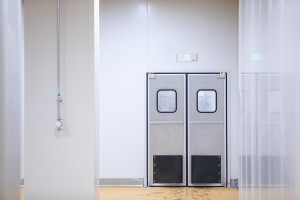Chain clean room door
The principle of the electric interlocking door: Install a micro switch on each of the first and second doors. When the first door is opened, the micro switch of this door controls the power supply of the second door to be disconnected; so only when the door is opened (the switch is installed on the door frame, the switch button is pressed on the door), the power of the second door To be connected. When the second door is opened, its micro switch cuts off the power supply of the first door, which means that the first door cannot be opened. The same principle, they control each other is called interlocking door.
The design of the linkage door consists of three parts: controller, electric lock, and power supply. Among them, there are independent controllers and split multi-door controllers. Electric locks often include female locks, electric bolt locks, and magnetic locks. Using different controllers, locks and power supplies will form different types of linkage devices, which also have different characteristics in design and construction.
In the design of various linkage doors, there are two types of linkage main objects. One type of linkage main body is the door itself, that is, when the door body of one door is separated from the door frame, the other door is locked. One door cannot be opened, and only when the door is closed again can the other door be opened. The other is the electric lock as the main body of the linkage, that is, the linkage between the two locks on the two doors. One lock is opened, the other lock cannot be opened, only when the lock is re-locked After that, the other lock can be opened.
The key to distinguish these two types of linkage types is the selection of the door status signal. The so-called door status refers to whether the door is open or closed. There are two ways to judge this state. One is to judge according to the state of the door sensor. When the door sensor is separated, it sends a signal to the controller, and the controller thinks that the door has been opened, because the door sensor is installed on the door frame and the door. Therefore, the linkage of the two doors that use the door sensor as the door status signal is the linkage of the door body. The second is to use the lock state signal of the lock itself as the signal for judging the state of the door. As soon as the lock has an action, the lock signal line sends a signal to the controller, and the controller considers the door to be opened. This is achieved in this way The main body of the linkage is an electric lock.
The difference between the above two types of linkage bodies is that when the door body is used as the linkage body, the linkage function can only be realized when a door is actually pushed or pulled open (the door sensor has been separated from the effective distance). If the electric lock is only opened and the door does not move, the linkage function does not exist, and the other door can still be opened at this time. When the lock is used as the main body of the linkage, the linkage function exists as long as the electric lock of one door is opened. At this time, no matter whether the door is actually pushed or pulled, the other door cannot be opened.







